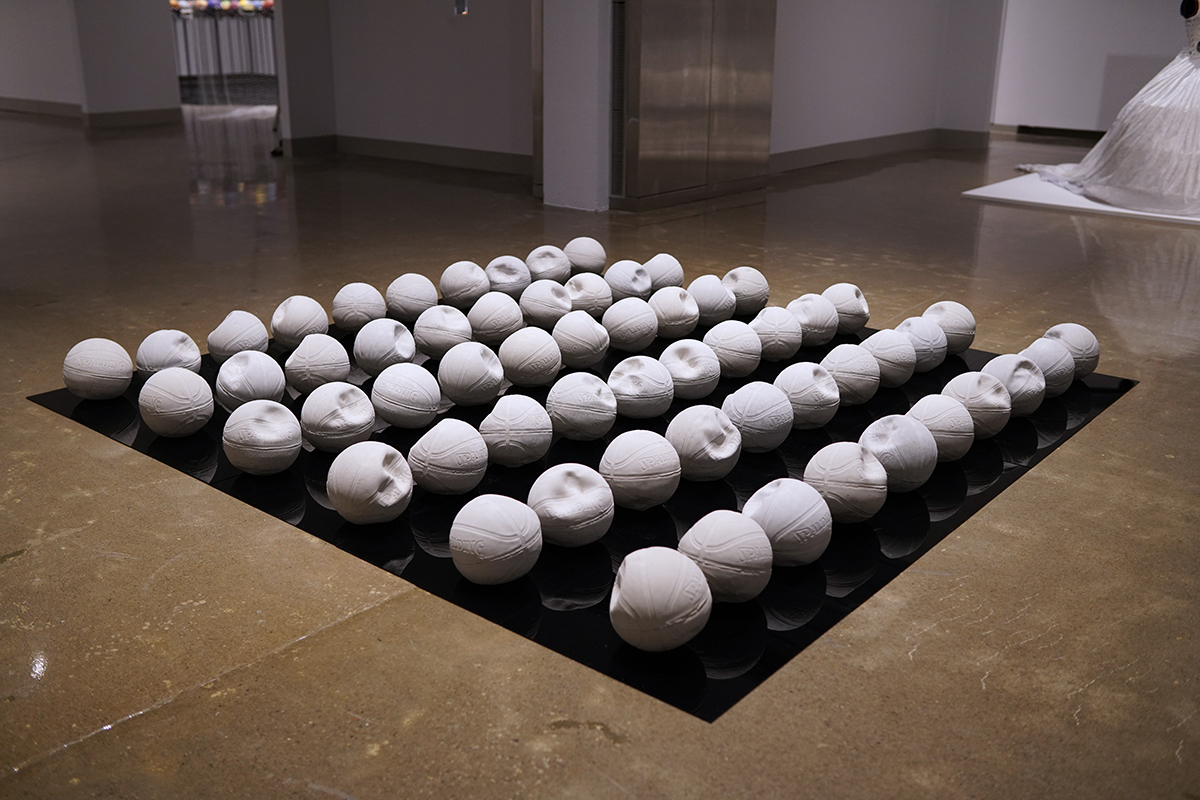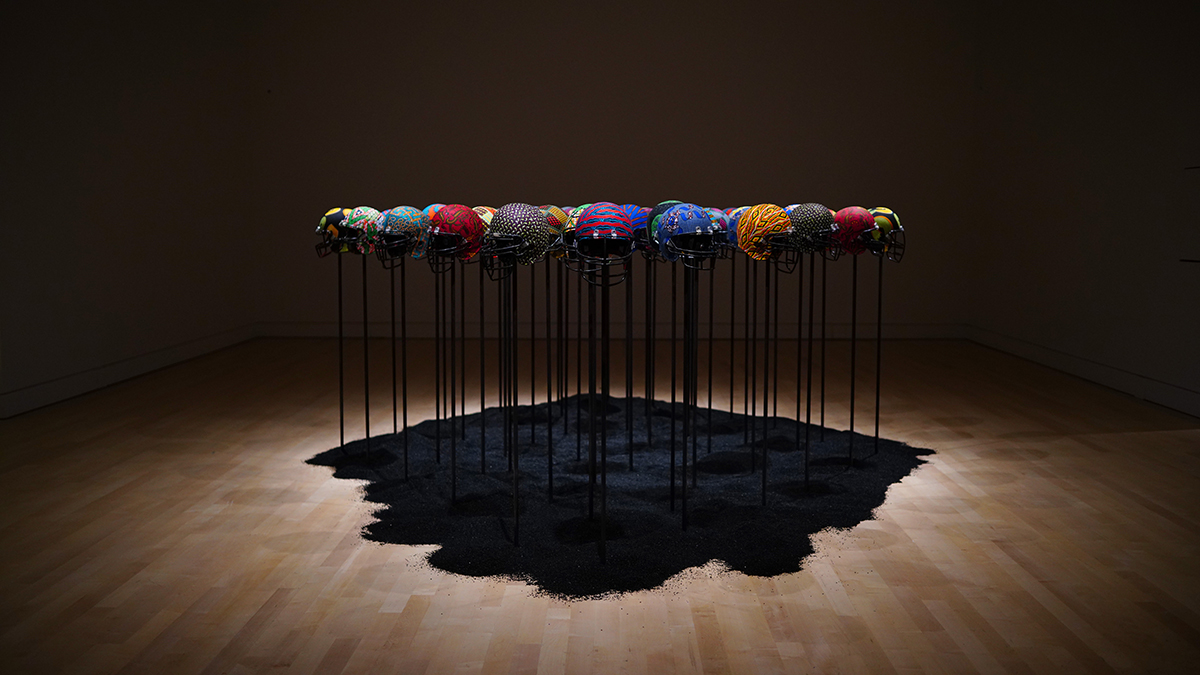It is often assumed by people who should know better that Esmaa Mohamoud is a man. On the opening days of the artist’s exhibitions, which typically focus on the troubled relationship between professional sports and Black masculinity, those dizzied patrons will materialize, uninformed, to search determinedly for the Man Behind the Work. What happens instead is that they discover twenty-eight-year-old Mohamoud and often say something like, “Oh! You’re a woman.” Nonplussed reactions don’t surprise her. “It’s probably the subject matter,” she tells me one April afternoon, visibly amused. “The work reads as masculine; I have lots of masculine energy.”
Sometimes a gallery visitor will ask whether she’s the artist and she’ll say no, point out some poor unsuspecting man flitting about the crowd, and say it’s him, he’s Esmaa Mohamoud—partly because she’s “super awkward and shy” but also because, despite her diffidence, she has a thing for the performative gesture. Like American artist Richard Serra, one of her artistic forebears, she creates installations with a certain grandeur: sculptures with gravity that engage the viewer’s body and force them to walk around the works rather than past them. This explains their notably large scale and her proclivity for industrial materials. (She is, for example, currently working on a field of 500 “indestructible” black dandelions that could probably fill a small bedroom; she sometimes tracks the progression of the installation on Instagram.)
Mohamoud makes sculptures about athletics, about Blackness, about gender, and sometimes about the ways those things rub up against one another to produce a social problem, if not a catastrophe. The spectre of bondage is sometimes raised: she frequently uses chains in her work. With these installations, Mohamoud draws an association between athleticism and historical forms of slavery. It’s a relationship that may seem, at first, unlikely, until she begins to guide viewers through her subject. Then it’s hard to unsee.
Listen to an audio version of this story
For more audio from The Walrus, subscribe to AMI-audio podcasts on iTunes.
“I use sports in my work not because I love it so much but as a tool to trick people,” Mohamoud says. “People are uncomfortable talking about race, but they aren’t uncomfortable talking about sports.” The subject is a Trojan horse. Sports bring people together—in boozy living rooms, in crowded bars, and in the streets. There’s something special and irrepressible about all that mutual excitement: for a moment, the world falls away, and entire cities light up with mass euphoria. There’s nothing quite like winning.
But artists ruin everything because they don’t care about your comfort. They aren’t in the business of consensus. Mohamoud wants to expose the monstrous underbelly of all that winning. Professional sports, she argues, are not some bastion of simple pleasure and equal opportunity—they’re all still moored to the same racial logic that warps the rooms these players must return to when they’ve finished performing in a stadium, basking in triumph and applause.
Esmaa Mohamoud grew up in London, Ontario, where she started boxing and playing tennis when she was nine. She was the middle child of four brothers who all played basketball though high school. Sports were at the centre of her suburban childhood universe, the grounding preoccupation that held everything together. They were a conduit for community and opportunity, a sacred foundation where upsets or defeats were resolvable because there was always another game to be played, another chance to be redeemed, another conversation to be had about statistics while a match played on the living room television. As sports informed her life, so they inform her art.
After school, she would rush home and descend into her basement, bag still strapped to her back, to catch a late-afternoon episode of Art Attack—an exuberant and mildly chaotic British TV series that taught kids, step-by-step, how to make art projects from materials like sponges and construction paper. When Mohamoud’s parents recognized her talent, they enrolled her in a free after-school art program. By sixteen, she knew she was to be an artist; by seventeen, she had begun her BFA at Western University.
Less than a decade since, Mohamoud’s work has been exhibited at the Art Gallery of Ontario, the Royal Ontario Museum, Montreal’s Museum of Fine Arts, and in New York and Los Angeles. In February, she was the only artist chosen from Canada by American painter Kehinde Wiley, of Obama presidential portrait fame, to attend a luxurious seaside residency program in Senegal. And, in May, she was longlisted for the 2021 Sobey Art Award.
In 2016, Mohamoud held an exhibition called #000000 Violence at the YYZ Artists’ Outlet, in Toronto’s Fashion District. She’d created an installation of sixty concrete basketballs, crafted to appear deflated and arranged in a grid on a black Plexiglas platform. (Each orb weighed thirty pounds and was designed to crack and fall apart as time passes.) That sculpture, Mohamoud has said, functioned as a kind of memorial for the young Black men across North America who grow up being told and believing they’ll someday make it into the NBA, that the NBA will be a long-awaited escape from poverty, and not warned that the odds are stacked against them—that the odds are always stacked against them.

“We nurture Black kids into being good at sports,” she says, “and then we’re surprised when things don’t work out.” Of the thousands of gifted players around the world vying to make their dreams come true, trading the fleeting pleasures of adolescence for late-night scrimmages and early morning practices, only sixty will be drafted into the NBA in any given year. “And, the next year,” Mohamoud adds, “there’ll be another set of Black men who’ve been conditioned to play in the NBA, to focus on only that, and they’ll get cycled through too.”
Looking at the sculpture, I remember feeling a bit deflated myself. I had, just over a year prior, quit soccer in the midst of a busy scouting season—partly in fear of putting too many eggs in one basket for a future that suddenly seemed, after a moment of embarrassing clarity, absurdly tenuous. I had been counting on a full-ride scholarship from an American university, had a reality check, changed course. “No pain, no gain,” I learned, is just masochism moonlighting as philosophy. Disappointments like that are common in sports, but Mohamoud’s work is far bigger and darker and more serious than any individual disappointment: she is talking about the disposability of Black people, who are everywhere integral for the sustainment of a rich social and cultural life but are eternally stuck with the short end of the stick.
The trouble, Mohamoud says, is that these athletes aren’t regarded as human beings. They exist instead in a paradoxical state, dehumanized in the way they’re deified and again dehumanized in the way they’re treated as chattel. “Black bodies are made to be deteriorated for entertainment,” she says, noting the abundance of Black players and the relative dearth of Black presidents or general managers. “When I think about the NBA or the NFL, it’s like, these players wear their owners’ names on their shirts. Like branding…. If players are traded, they just have to up and move their entire lives. Black people are farmed in and farmed out. And yes, I know they’re getting paid millions of dollars to do that. Maybe they shouldn’t complain. But it’s just apparent to me that there are correlations between the ways Black bodies play for entertainment now and something like Mandingo fighting, for example.”
Anyone who’s seen the film Django Unchained may have learned the term “Mandingo fighting” by way of Quentin Tarantino’s famously slanted, ahistorical narrative. But there is a kernel of truth at the heart of the filmmaker’s cartoonish staging of slaves fighting to the death to earn small fortunes for their bored and greedy owners. Though it’s still a largely debated practice among researchers, historian Richard Bardolph has said that enslaved people “were frequently set upon each other like gamecocks” while fevered onlookers made bets on the outcome. They weren’t death matches, but because slave boxers were sometimes promised freedom in exchange for winning prize money for plantation overseers, there was incentive to conquer one another.
As for today’s athletes, “They’ve been given so much power and so much affluence,” Mohamoud says, “yet, at the same time, they have little to no power at all.” One has only to invoke the name Colin Kaepernick—who was effectively blacklisted from the NFL for taking a knee during the national anthem—to find knowing faces wince in familiarity. Any athlete who dares strive to improve their social conditions hears the crack of an invisible whip. They’re told to shut up and play, which, in any light, makes a salary look more like a gag order. Trying to echolocate your humanity against the surface of an institution that routinely disregards it, that prefers to instead trade your personhood for the profit it can mine from your body—Is this not a universal dimension of being a Black entertainer? “No one cares what these players actually have to say,” Mohamoud says. “The league only really cares about making a dollar.” Professional sports are businesses. There are owners, consumers, and products. It doesn’t take much to discern which category the athlete belongs to.
Mohamoud’s touring spring exhibition at the Art Gallery of Hamilton, To Play in the Face of Certain Defeat, brought together a sizable part of her work to explore the industry of professional sports as a “covert form of neo-slavery.” A three-channel film, titled From the Ground We Fall (2019), which has also been presented as a physical installation, documents two football players attached by a set of chains, fighting—and, inevitably, failing—to pull away from each other amid the sweltering heat. Mohamoud asked the men, one of whom is her brother, to “tear each other apart” for hours, and the video illuminates the ways an entertainment industry can be improvised from the degradation of the Black body, how an audience becomes complicit via its voyeurism.
Glorious Bones (2019)—a series of forty-six football helmets printed with colourful African textiles and impaled on steel rods in a bed of black faux soil—stands out. The protective interior padding of each helmet has been carved out and removed, obliterating the functionality entirely. The sculpture takes on a score of sinister meanings. (A friend of mine said they look like severed heads on pikes.) In the early nineteenth century, evolutionary theorists and so-called scientists believed that people of African descent had thicker, denser bones that were less likely to break and rendered Black people impervious to pain. Back then, newspaper editors liked to publish fantastical stories, often about Black people whose skulls were brawny enough to withstand beatings and vehicular catastrophes without getting cracked; such research helped justify inhumane treatment and, later, influenced modern thinking about sporting prowess and potential. Black victory could then be excused as the result of physiology rather than of talent.

In the NFL today, nearly 80 percent of defensive players—who are more likely to become concussed—are Black. “That tells you we’ve been trained to take pain,” says Mohamoud. Recent lawsuits allege that Black players are less likely to receive payouts in dementia-related league settlements since, for years, NFL-appointed neuropsychologists used race-based benchmarks to determine whose cognitive skills had declined because of football and whose were already low to begin with. (In June, the league promised to halt the “race-norming” practice, which began as an affirmative action effort and has roots in plantation slavery.)
On the other hand, 81 percent of NFL quarterbacks—who are considered the most important players on the field and who tend to make the most money—are white, even though most league players are Black. Modern rosters may not be consciously built on race. But, between 1933 and 1946, Black players were unofficially barred from playing in the league entirely because the Great Depression stoked an unsurprising racial anxiety among white Americans who felt that their jobs were being stolen by Black people. Quarterback was one of the last positions to be desegregated, possibly because race scientists had succeeded in convincing everyone that “thinking positions”—quarterback, centre, inside linebacker—ought not be filled by players who were genetically predisposed to being intellectually inferior, never mind that it was all untrue.
Sports possess an undeniable beauty and incalculable value far beyond the economic. Mohamoud isn’t trying to abolish anything. Her critique is an act of love. She’s only performing a clever magic trick of what scholar Saidiya Hartman calls “defamiliarizing the familiar,” gesturing at the quotidian and peeling back its illusions to reveal the terror and violence underneath.
These games, for Mohamoud, are useful metaphors for how Black masculinity is performed and for the limitations imposed on that performance—on its tenderness or aggression, its vulnerability or edge, and the forced negotiation between each. It’s a way to think through how we metabolize the sports stars we obsessively revere and to explore the complicated systems that produce them. It isn’t a new conversation so much as a historical and intergenerational one, a decades-long dialogue between artists like David Hammons (who in 1990 called basketball “a problem in the Black community”) and Awol Erizku (who often uses basketball ephemera in his work today) about athletics and race and capitalism. Mohamoud’s One of the Boys (2017) recalls Mark Bradford’s Practice (2003), a video the artist filmed of himself, dressed as a basketball player in a nineteenth-century-style skirt, trying to shoot against a violent gust of wind. And conceptual artist Hank Willis Thomas’s photographic series Strange Fruit, from 2011, features an astonishing image called The Cotton Bowl: a field bisected into a thriving cotton plantation and a lush football pitch, with two Black men, each their own sort of labourer, facing off at the centre.
Mohamoud’s greatest gift is to upend our conception of history and force us to reconsider how race comes to bear on all social relations, even and perhaps especially in those corners we treat as an escape from the world’s ills. She knows there is no area of social or cultural or political life, including professional sports, that can be divorced entirely from the problems of humanity. Escapism isn’t so different from dissociation. And, in the end, doesn’t it feel a bit dishonest to say it’s all just a game?
July 14, 2021: In an earlier version of this story, a source stated that, in professional sports, coaches are called owners. In fact, they are not usually referred to this way.



